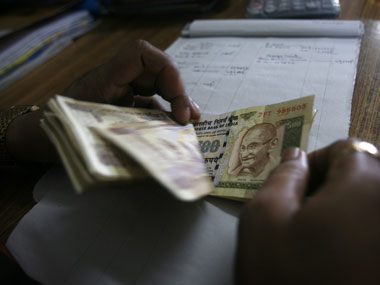The rupee lost 8.8 percent against the dollar during the September-ending quarter, its largest quarterly fall since the same period in 2008. The currency was pummelled by growing risk aversion by jittery global investors who dumped assets across emerging markets.
The rupee was also the worst performer among major Asian peers. The currency’s fall is likely to further affect the performance of Indian companies, already battered by high interest costs and input costs, as well as cooling demand. While the most obvious beneficiaries are likely to be exporters, several other companies will suffer the adverse effects of a falling currency.
A report by Goldman Sachs highlighted which companies would benefit from the rupee’s fall against the greenback and which wouldn’t. Here is what the brokerage had to say.
[caption id=“attachment_101027” align=“alignleft” width=“380” caption=“Rupee on a roller coaster ride. Reuters”]
 [/caption]
[/caption]
Companies hit because of higher import costs:
India Cements: The company’s profitability could be hurt by about 8 percent because of higher costs of imported raw materials (coal, gypsum, etc). India Cements imports 65-75 percent of its coal requirements, which makes its operations vulnerable to currency depreciation.
Hindustan Unilever: More than 75 percent of its raw materials costs are affected by global commodity prices. A sustained rupee depreciation could lead to a 6-8 percent jump in input costs.
Impact Shorts
More ShortsCompanies hurt by higher foreign debt costs:
Bharti Airtel: A significant portion of the forex impact of its $10 billion loan will be reflected through its balance sheet, not its profit and loss account, according to the International Financial Reporting Standards accounting policy. That will reduce the impact of the fall in the rupee’s value on earnings. Goldman Sachs estimates the impact of currency movements on Bharti’s earnings for the financial year ending March 2012 is could be Rs 800 crore, or 12.9 percent of earnings per share.
Reliance Communications: At the end of June, 78 percent of the company’s debt was denominated in foreign currency; the debt is not hedged* at all. However, we do not expect any impact of translational losses on the company’s profitability given its accounting policies. Indeed, RCom could positively benefit on revenues as Globalcom’s (an overseas subsidiary) revenues are dollar-denominated (if there is no slowdown in the subsidiary’s revenues), although there could be a negative effect on interest and principal repayments, particularly on its foreign currency convertible bonds scheduled to be redeemed in February 2012.
GMR Infrastructure: There are some external commercial borrowings on its Hyderabad Airport assets, as well as on some power assets. Goldman Sachs expects mark-to-market losses# of up to approximately Rs 800 million- Rs 1 billion on these debts in the quarter ending September. It also expects cash losses to the extent of Rs 100-150 million for the quarter.
Jaiprakash Associates: The company has about 10 percent of its consolidated debt denominated in foreign currency. Since it has no natural hedge, the company could face mark-to-market losses of Rs 750 million to Rs 1 billion in the quarter.
Other companies named are Adani Power, Lanco Infratech, Reliance Infrastructure and Power Finance Corporation.
Companies likely to benefit because of high proportion of foreign revenues:
Reliance Industries: The rupee’s depreciation could have a net positive impact of about 4-5 percent on Reliance’s earnings. Higher revenues and profits are likely as 60 percent of RIL’s turnover consists of exports, which partly offset the expenditure on foreign currency debt. The company hedges its currency exposures to some extent.
Hindalco: While Hindalco’s US subsidiary carries $4.1 billion of debt on its books, Hindalco itself is unlikely to be affected by the forex fluctuations. In fact, it could see a net 2 percent gain in profitability from the rupee’s fall, as domestic product prices of the company are linked to import parity prices, which have climbed due to the rupee’s dive in value. To some extent, that will offset the higher costs of imported raw materials.
Cairn India: The rupee’s depreciation will have a positive impact on Cairn as the company prices its crude oil sales in dollars, which will lead to higher revenues and profits. Net profit could be higher by about 7 percent if the rupee-dollar rate remains at Rs 48 for the rest of this financial year, Goldman Sachs said.
HCL Tech: With 56 percent of its revenues in dollars, there could be an 8-10 percent positive impact on this financial year’s earnings per share. This does not include the impact of forex hedging; however, HCL Tech (and Infosys) have lower levels of hedges compared with TCS and Wipro (as a percentage of revenues) implying lower hedging losses.
Infosys and Tata Power are the other two companies likely to benefit from the rupee’s slide.
Notes:
*A foreign exchange hedge is a method used by companies to eliminate or hedge foreign exchange risk resulting from transactions in foreign currencies. In contrast, a__n unhedged transaction is not protected against loss by balancing/offsetting/compensating transactions.
#When the market value of an asset falls after the investor has bought it, he may decide to assign the new market value to the investment. In that case, there is a notional loss on that asset, even if the investor does not sell the asset. That loss is called mark-to-market and it aims to give investors a clearer picture of the company’s assets or other holdings.
)